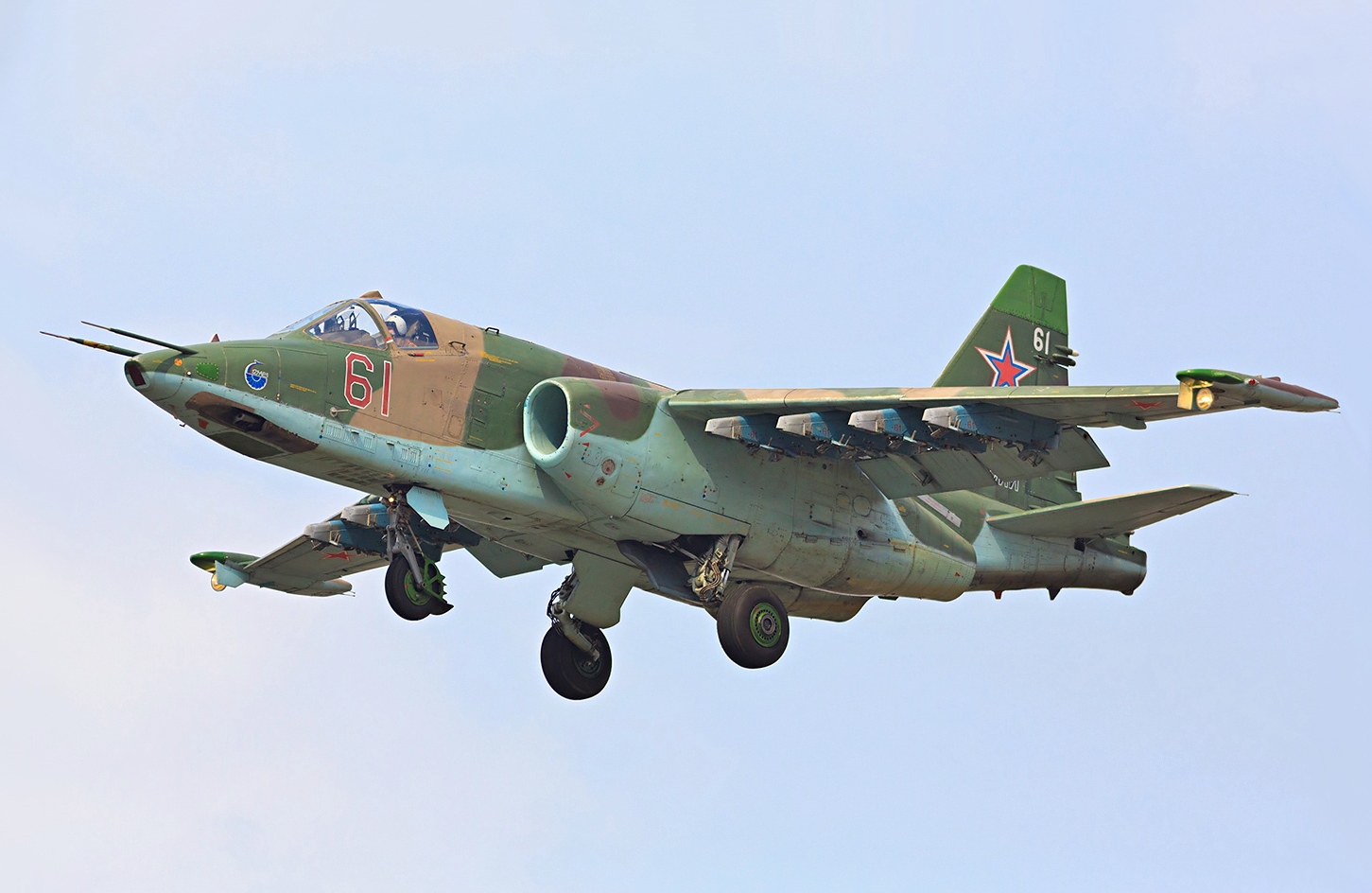Rare footage has emerged of Russian Su-25 ‘Frogfoot’ launching rockets directly into Ukrainian positions to the west of Donetsk. The video was filmed somewhere over Maryinka, a small city located in the Pokrovsk district of the Donetsk region, according to OSINT analysts.
The brief video clip that lasts for 54 seconds shows two Su-25 attack aircraft flying low and firing several rockets toward what seem to be Ukrainian positions.
Rate footage of Russian Su-25 attack aircraft launching rockets downwards at Ukrainian positions west of Donetsk without firing them into the air. https://t.co/dTRs2qUzqs pic.twitter.com/Qrs55n5kuy
— Rob Lee (@RALee85) November 1, 2022
A notable feature of the video is that the Frogfoots are seen launching rockets downward toward their target without firing them into the air, which is rare.
The Su-25 usually fires its rockets in a gentle climb for better range when it wants to avoid coming close to the target because of the threat from the enemy man-portable air defense systems (MANPADS).
The weapon attack computer on the aircraft factors in weapon ballistics and prevailing winds, and computes the range, height, and climb angle for accurate delivery and provides launch cues to the pilot.

If the aircraft is close to the target, it fires the rockets into the target from height in a gentle dive, as observed in the video. The accuracy of the attack is greater when the range is short, but the risk to the pilot and machine is greater.
Su-25s Suffer The Most Losses
Russian and Ukrainian fighter pilots have been flying their aircraft dangerously close to the ground, mainly to avoid detection by the enemy’s radar systems.
In this case, the Russian Su-25s seem to be flying close to the target to achieve accuracy in their attacks.
?️A pair of Ukrainian Su-25 casually flying at low altitude above a highway #UkraineRussiaWar pic.twitter.com/9YyVGjiB79
— MilitaryLand.net (@Militarylandnet) September 8, 2022
Regardless of the reason, the low-flying tactic exposes the aircraft to hostile MANPADS that have accounted for most of the aircraft shoot-downs by both sides of the ongoing Ukraine conflict, as discussed at a great length in an earlier EurAsian Times report.
The Frogfoot, which has been predominantly employed by the air forces of both sides for ground attacks, has sustained the most losses of any fixed-wing tactical jet type used in the ongoing war, a reflection of the high-risk envelop of MANPADS and other air defenses these aircraft fly in.
A pair of #Ukrainian SU-25 attack aircraft, at low altitudes, skillfully escape from the shelling of #Russian #MANPADS in the Severodonetsk region.#Ukraine #UkraineRussianWar #Ukrainian #Russia #SU25 #RussianUkrainianWar pic.twitter.com/eunxjRN09B
— News of Ukraine (@uasupport999) May 15, 2022
According to the figures compiled by the military tracking blog Oryx based on visual confirmations, 37 Su-25s have been destroyed, with 23 belonging to Russia. Of those 23, four are believed to have been destroyed in non-combat-related incidents.
At least one Su-25 on both sides has suffered damages beyond economical repair.
Su-25 Grach (‘Rook’)
The Su-25 Grach (‘Rook’) is Soviet-era close air support (CAS) aircraft known by the NATO reporting name Frogfoot.
Designed by the Sukhoi Design Bureau, it is intended to attack small mobile and stationary ground targets. The aircraft can also engage low-speed air targets at the forward edge and in the nearest tactical and operational depth.

The aircraft has a maximum take-off weight of 17,600 kilograms and is powered by the Soyuz/Gavrilov R-195 turbojets, each generating a thrust of 44.17kN. It can attain a top speed of 950 kilometers per hour.
The range of the Su-25 is 750 kilometers, while its combat radius is 375 kilometers. The aircraft can climb at a rate of 58 meters per second and has a service ceiling of 7000 meters.
The Frogfoot has ten underwing pylons that can carry a range of air-to-air and air-to-ground weapon systems, including the Kh-23, Kh-25ML, and Kh-29l air-to-ground missiles and the R-3S and R-60 air-to-air missiles on the smaller outboard pylons.
The aircraft can be fitted with UB-32A pods for 57mm S-5 rockets, B-8M1 pods for 80mm S-8 rockets, S-24 240mm guided rockets, and S-25 330mm guided rockets.
The aircraft also has a twin-barrel gun, the Gryazev-Shipunov GSh-30-II 30 mm, installed on the bottom side of its fuselage on the port side, which can carry 250 rounds of ammunition and is capable of firing at a burst rate of 3,000 rounds per minute.
The SPPU-22 gun pods can also be installed on the underwing pylons, which carry the GSh-23 mm twin-barrel guns, each with 260 rounds.
The Russian Sukhoi Design Bureau initiated a program in 2001 to modify the Su-25 into an upgraded version of the Su-25SM attack aircraft, which entered the service with the Russian Aerospace Force (VKS) in 2007.
The upgraded aircraft model features a navigational computer, a Pastel countermeasures suite, an SUO-39 fire control system, and a Phazotron Kopyo-25M radar.
As discussed by EurAsian Times recently, new combat modes on the upgraded Su-25SM version allow the aircraft to employ guided air-to-surface missiles accurately in level flight.
- Contact the author at tanmaykadam700(at)gmail.com
- Follow EurAsian Times on Google News




